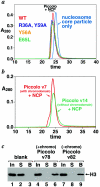The Saccharomyces cerevisiae Piccolo NuA4 histone acetyltransferase complex requires the Enhancer of Polycomb A domain and chromodomain to acetylate nucleosomes
- PMID: 15964809
- PMCID: PMC1156996
- DOI: 10.1128/MCB.25.13.5535-5542.2005
The Saccharomyces cerevisiae Piccolo NuA4 histone acetyltransferase complex requires the Enhancer of Polycomb A domain and chromodomain to acetylate nucleosomes
Abstract
Chromatin modification complexes are key gene regulatory factors which posttranslationally modify the histone component of chromatin with epigenetic marks. To address what features of chromatin modification complexes are responsible for the specific recognition of nucleosomes compared to naked histones, we have performed a functional dissection of the Esa1-containing Saccharomyces cerevisiae Piccolo NuA4 histone acetyltransferase complex. Our studies define the Piccolo determinants sufficient to assemble its three subunits into a complex as well as Piccolo determinants sufficient to specifically acetylate a chromatin template. We find that the conserved Enhancer of Polycomb A (EPcA) homology region of the Epl1 component and the N-terminal 165 amino acids of the Yng2 component of Piccolo are sufficient with Esa1 to specifically act on nucleosomes. We also find that the Esa1 chromodomain plays a critical role in Piccolo's ability to distinguish between histones and nucleosomes. In particular, specific point mutations in the chromodomain putative hydrophobic cage which strongly hinder growth in yeast greatly reduce histone acetyltransferase activity on nucleosome substrates, independent of histone methylation or other modifications. However, the chromodomain is not required for Piccolo to bind to nucleosomes, suggesting a role for the chromodomain in a catalysis step after nucleosome binding.
Figures






Similar articles
-
Structure and nucleosome interaction of the yeast NuA4 and Piccolo-NuA4 histone acetyltransferase complexes.Nat Struct Mol Biol. 2011 Oct 9;18(11):1196-203. doi: 10.1038/nsmb.2128. Nat Struct Mol Biol. 2011. PMID: 21984211 Free PMC article.
-
Piccolo NuA4-catalyzed acetylation of nucleosomal histones: critical roles of an Esa1 Tudor/chromo barrel loop and an Epl1 enhancer of polycomb A (EPcA) basic region.Mol Cell Biol. 2013 Jan;33(1):159-69. doi: 10.1128/MCB.01131-12. Epub 2012 Oct 29. Mol Cell Biol. 2013. PMID: 23109429 Free PMC article.
-
Site specificity analysis of Piccolo NuA4-mediated acetylation for different histone complexes.Biochem J. 2015 Dec 1;472(2):239-48. doi: 10.1042/BJ20150654. Epub 2015 Sep 29. Biochem J. 2015. PMID: 26420880 Free PMC article.
-
Biochemical and structural characterization of recombinant histone acetyltransferase proteins.Methods Enzymol. 2004;376:106-19. doi: 10.1016/S0076-6879(03)76007-8. Methods Enzymol. 2004. PMID: 14975301 Review. No abstract available.
-
Histone acetylation: facts and questions.Chromosoma. 1994 Dec;103(7):441-9. doi: 10.1007/BF00337382. Chromosoma. 1994. PMID: 7720410 Review.
Cited by
-
Identification of an Immunogenic Medulloblastoma-Specific Fusion Involving EPC2 and GULP1.Cancers (Basel). 2021 Nov 21;13(22):5838. doi: 10.3390/cancers13225838. Cancers (Basel). 2021. PMID: 34830991 Free PMC article.
-
Profiling of immune responses by lactate modulation in cervical cancer reveals key features driving clinical outcome.Heliyon. 2023 Mar 25;9(4):e14896. doi: 10.1016/j.heliyon.2023.e14896. eCollection 2023 Apr. Heliyon. 2023. PMID: 37151676 Free PMC article. Review.
-
Heterochromatin assembly by interrupted Sir3 bridges across neighboring nucleosomes.Elife. 2016 Nov 11;5:e17556. doi: 10.7554/eLife.17556. Elife. 2016. PMID: 27835568 Free PMC article.
-
Structure and nucleosome interaction of the yeast NuA4 and Piccolo-NuA4 histone acetyltransferase complexes.Nat Struct Mol Biol. 2011 Oct 9;18(11):1196-203. doi: 10.1038/nsmb.2128. Nat Struct Mol Biol. 2011. PMID: 21984211 Free PMC article.
-
Deciphering how the chromatin factor RCC1 recognizes the nucleosome: the importance of individuals in the scientific discovery process.Biochem Soc Trans. 2012 Apr;40(2):351-6. doi: 10.1042/BST20110734. Biochem Soc Trans. 2012. PMID: 22435811 Free PMC article. Review.
References
-
- Akhtar, A., D. Zink, and P. B. Becker. 2000. Chromodomains are protein-RNA interaction modules. Nature 407:405-409. - PubMed
-
- Balasubramanian, R., M. G. Pray-Grant, W. Selleck, P. A. Grant, and S. Tan. 2002. Role of the Ada2 and Ada3 transcriptional coactivators in histone acetylation. J. Biol. Chem. 277:7989-7995. - PubMed
-
- Becker, P. B., and W. Horz. 2002. ATP-dependent nucleosome remodeling. Annu. Rev. Biochem. 71:247-273. - PubMed
Publication types
MeSH terms
Substances
Grants and funding
LinkOut - more resources
Full Text Sources
Other Literature Sources
Molecular Biology Databases
Miscellaneous
